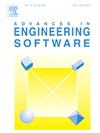基于深度神经网络的头部损伤准则估计在引擎盖结构设计中更有效地评估行人保护性能
IF 5.7
2区 工程技术
Q2 COMPUTER SCIENCE, INTERDISCIPLINARY APPLICATIONS
引用次数: 0
摘要
在新车型的开发初期,需要快速评估行人保护性能,以加快发动机罩结构的设计过程。目前的评估方法依赖于有限元(FE)模拟来计算阀盖上指定点的头部损伤标准(HIC)值,然后再进行更昂贵的使用头部撞击器的真实冲击试验。然而,基于有限元的方法通常需要几天时间来完成网格划分、边界条件设置和HIC计算,以评估单个候选设计。为了进一步提高评估效率,本文提出了一种基于深度学习的HIC评估方法。提出了一种端到端的深度神经网络模型,该模型可以直接生成HIC值,而无需借助于有限元方法。它根据HIC的定义,使用与面板高度、结构差异、厚度和封头类型有关的七个变量作为输入。卷积层用于聚合每个目标点周围的结构信息。为了证明所提出方法的有效性,交叉验证结果基于从28辆汽车收集的超过5000个目标点的数据集。对于绿色目标区域,平均HIC估计精度为93.1%,优于以往报道的83%的结果。通过与传统支持向量回归方法的比较,证明了该方法的优越性。本文章由计算机程序翻译,如有差异,请以英文原文为准。
Deep neural network based head injury criterion estimation for more efficient pedestrian protection performance evaluation in bonnet structure design
In the early development stage of a new car model, fast evaluation of pedestrian protection performance is required to accelerate the bonnet structure design process. Current evaluation methods rely on finite element (FE) simulation to calculate the Head Injury Criterion (HIC) values at specified points on the bonnet, before proceeding to the more expensive real-world impact test using headform impactors. However, the FE based approach typically takes several days to complete the meshing, boundary condition setting and HIC calculation to evaluate a single design candidate. To further increase the evaluation efficiency, this paper presents a novel HIC estimation approach based on deep learning. An end-to-end deep neural network model is proposed which can directly generate the HIC value without resorting to FE methods. It uses seven variables pertaining to the panel height, structural difference, thickness and head type as the input based on the definition of HIC. Convolution layers are utilised to aggregate the surrounding structural information for each target point. To demonstrate the effectiveness of the proposed approach, cross validation results are presented based on a dataset of over five thousands target points collected from 28 cars. For the green target regions, the average HIC estimation accuracy is 93.1 %, which outperforms the result of 83 % reported in previous work. A comparison with the traditional support vector regression method demonstrates the advantages of the proposed approach.
求助全文
通过发布文献求助,成功后即可免费获取论文全文。
去求助
来源期刊

Advances in Engineering Software
工程技术-计算机:跨学科应用
CiteScore
7.70
自引率
4.20%
发文量
169
审稿时长
37 days
期刊介绍:
The objective of this journal is to communicate recent and projected advances in computer-based engineering techniques. The fields covered include mechanical, aerospace, civil and environmental engineering, with an emphasis on research and development leading to practical problem-solving.
The scope of the journal includes:
• Innovative computational strategies and numerical algorithms for large-scale engineering problems
• Analysis and simulation techniques and systems
• Model and mesh generation
• Control of the accuracy, stability and efficiency of computational process
• Exploitation of new computing environments (eg distributed hetergeneous and collaborative computing)
• Advanced visualization techniques, virtual environments and prototyping
• Applications of AI, knowledge-based systems, computational intelligence, including fuzzy logic, neural networks and evolutionary computations
• Application of object-oriented technology to engineering problems
• Intelligent human computer interfaces
• Design automation, multidisciplinary design and optimization
• CAD, CAE and integrated process and product development systems
• Quality and reliability.
 求助内容:
求助内容: 应助结果提醒方式:
应助结果提醒方式:


